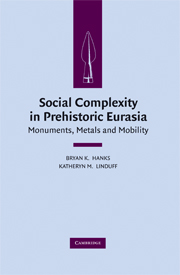Book contents
- Frontmatter
- Contents
- Contributors
- Foreword: From Myth to Method: Advances in the Archaeology of the Eurasian Steppe
- CHAPTER 1 Introduction: Reconsidering Steppe Social Complexity within World Prehistory
- PART ONE FRAMING COMPLEXITY
- PART TWO MINING, METALLURGY, AND TRADE
- PART THREE FRONTIERS AND BORDER DYNAMICS
- CHAPTER 13 Introduction
- CHAPTER 14 Violence on the Frontiers? Sources of Power and Socio-Political Change at the Easternmost Parts of the Eurasian Steppe during the Late Second and Early First Millennia BCE
- CHAPTER 15 First-Millennium BCE Beifang Artifacts as Historical Documents
- CHAPTER 16 Blurring the Boundaries: Foragers and Pastoralists in the Volga-Urals Region
- PART FOUR SOCIAL POWER, MONUMENTALITY, AND MOBILITY
- Index
CHAPTER 13 - Introduction
from PART THREE - FRONTIERS AND BORDER DYNAMICS
Published online by Cambridge University Press: 26 January 2010
- Frontmatter
- Contents
- Contributors
- Foreword: From Myth to Method: Advances in the Archaeology of the Eurasian Steppe
- CHAPTER 1 Introduction: Reconsidering Steppe Social Complexity within World Prehistory
- PART ONE FRAMING COMPLEXITY
- PART TWO MINING, METALLURGY, AND TRADE
- PART THREE FRONTIERS AND BORDER DYNAMICS
- CHAPTER 13 Introduction
- CHAPTER 14 Violence on the Frontiers? Sources of Power and Socio-Political Change at the Easternmost Parts of the Eurasian Steppe during the Late Second and Early First Millennia BCE
- CHAPTER 15 First-Millennium BCE Beifang Artifacts as Historical Documents
- CHAPTER 16 Blurring the Boundaries: Foragers and Pastoralists in the Volga-Urals Region
- PART FOUR SOCIAL POWER, MONUMENTALITY, AND MOBILITY
- Index
Summary
The transformation of the Eurasian steppe that took place from the end of the second to the middle of the first millennium bce presents a host of questions. That such a transformation took place during that period is clear. The archaeological remains of fortified sites and settlements with mixed agro-pastoral economies of the Bronze Age disappear and are replaced by more-extensive pastoral economies where permanent structures are few and most archaeological material comes from tombs.
The three chapters here examine some of the most contentious questions in the field today from different times and places. The most hotly debated of these have been whether the introduction of a more extensive steppe pastoralism characteristic of the horse-riding nomads at the end of the period was a product of population migrations, invasions by elite groups bringing a new culture with them, or the adoption of a new way of life by an existing population. The next most contentious question is whether the growing size and complexity in these new societies' political structures was the product of an indigenous internal development or a reaction to external forces. This issue has led to debate about the nature of cross-cultural frontier relations with neighboring sedentary societies, particularly China. However, archaeologists have increasingly insisted on the importance of examining the steppe's northern frontier with the Eurasian forest zone and the foraging societies that inhabited it.
- Type
- Chapter
- Information
- Social Complexity in Prehistoric EurasiaMonuments, Metals and Mobility, pp. 235 - 240Publisher: Cambridge University PressPrint publication year: 2009
- 1
- Cited by



